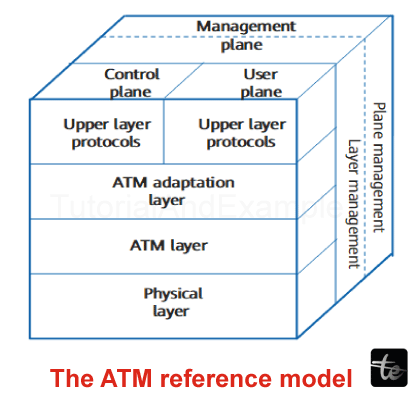ATM Network
ATM(Asynchronous Transfer Mode) network is a unique telecommunications technology that organizes data into fixed-size cells, typically 53 bytes each, distinct from traditional networks that use variable-sized packets. These cells are sent at different times, allowing diverse data types to share the same network path.
ATM stands out with its connection-oriented approach, creating virtual paths or circuits between endpoints to ensure dependable data delivery. These connections can be permanent or on-demand, offering flexibility in resource management and accommodating various service levels.
Prioritizing Quality of Service (QoS), ATM allocates bandwidth and orders traffic, enabling efficient real-time transmissions like voice and video, making it ideal for multimedia. Despite its past use in local and wide area networks, ATM's prevalence has waned due to competition from Ethernet and IP-based alternatives better suited to today's networking needs.
ATM Network Layers

1. The Physical Layer in an ATM network sends digital information through wires or cables. It decides how much power to use, which cables to use (like fiber-optic or copper), how things connect, and how fast the information travels. This layer ensures the information goes from one place to another correctly and without mistakes. It's like the starting point that sets the stage for everything else to work smoothly in the network.
2. Controls access to the network by authenticating and authorizing users, devices, or applications based on predefined policies.
3. Creates virtual network partitions to allow multiple independent networks to coexist on the same physical infrastructure.
4. Media Access Control (MAC) Layer: Manages access to the physical transmission medium to avoid collisions and ensure efficient data transfer.
5. Cell Format Layer: Defines the format and structure of ATM cells, including headers, payloads, and error-checking mechanisms.
6. The ATM Layer in an ATM network creates, routes, and moves data cells. It sets up virtual paths for connections, deals with addresses, and ensures the data stays accurate and complete. This layer is like a traffic manager for data cells, ensuring they reach their destinations correctly.
Characteristics of ATM Network
1. ATM Network supports point-to-multipoint communication, making it suitable for video conferencing and broadcasting applications.
2. ATM enables advanced traffic engineering techniques, such as dynamic routing and load balancing, to optimize network performance.
3. ATM can be deployed in various network topologies, including star, mesh, and ring configurations, providing flexibility in network design.
4. ATM's connection-oriented nature and error-handling mechanisms contribute to reliable data transport, which is critical for applications that require guaranteed delivery.
5. ATM can be integrated with other networking technologies, allowing for hybrid networks that leverage the strengths of different approaches.
Applications of ATM Network
1. ATM networks facilitate data exchange and collaboration among researchers in various scientific disciplines.
2. ATM can support remote education and virtual workplaces by enabling seamless data transmission and interaction.
3. ATM's efficient data handling can enhance the performance of social networking platforms, supporting multimedia content sharing and interactions.
4. ATM networks can facilitate data transmission and multimedia content delivery for cultural events, exhibitions, and art installations.
5. ATM supports data exchange in the tourism industry for hotel reservations, tour booking, and visitor information.
6. ATM networks enable real-time data transmission from agricultural sensors, helping farmers optimize crop management and resource allocation.
7. ATM can transmit data from remote environmental monitoring stations, supporting conservation efforts and data analysis.
8. ATM's predictability and efficiency make it suitable for transmitting data to and from satellites, enhancing satellite communication systems.
Advantages of ATM Network
1. ATM's fixed-size cells and connection-oriented setup contribute to low latency, making it suitable for real-time interaction applications.
2. ATM's QoS capabilities make it a good choice for transmitting voice traffic, ensuring clear and reliable voice communication.
3. ATM's ability to prioritize traffic helps ensure that critical data receives appropriate treatment, enhancing the overall network performance.
4. ATM can integrate with legacy systems, allowing organizations to leverage their investments in older technology.
5. The layered architecture of ATM provides a structured framework for designing and managing complex networks.
6. ATM's ability to prioritize and allocate bandwidth ensures high-quality transmission of voice and video streams.
Disadvantages of ATM Network
1. Despite error correction mechanisms, ATM networks can still be susceptible to network failures that impact data transmission.
2. Transitioning from existing network technologies to ATMs can be disruptive and costly, especially for organizations with established infrastructures.
3. ATM has lost industry momentum to newer and more widely adopted technologies, declining innovation and support.
4. The complexity of ATM networks can lead to longer deployment times and increased chances of configuration errors.
5. ATM may have compatibility issues when connecting with non-ATM networks, leading to challenges in integrating diverse technologies.
6. ATM's fixed cell size may result in inefficient bandwidth use for small data packets, as larger cells are used for transmission.
7. As ATMs have declined in popularity, the development of new standards and technologies for ATM networks has slowed down.
8. Implementing and managing ATM networks requires specialized knowledge and training, adding to the learning curve for network administrators.
9. To ensure QoS, ATM networks may need to be over-provisioned, leading to underutilization of resources during periods of low demand.